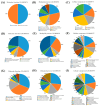Proteomic Analysis of Domestic Cat Blastocysts and Their Secretome Produced in an In Vitro Culture System without the Presence of the Zona Pellucida
- PMID: 38673927
- PMCID: PMC11050229
- DOI: 10.3390/ijms25084343
Proteomic Analysis of Domestic Cat Blastocysts and Their Secretome Produced in an In Vitro Culture System without the Presence of the Zona Pellucida
Abstract
Domestic cat blastocysts cultured without the zona pellucida exhibit reduced implantation capacity. However, the protein expression profile has not been evaluated in these embryos. The objective of this study was to evaluate the protein expression profile of domestic cat blastocysts cultured without the zona pellucida. Two experimental groups were generated: (1) domestic cat embryos generated by IVF and cultured in vitro (zona intact, (ZI)) and (2) domestic cat embryos cultured in vitro without the zona pellucida (zona-free (ZF group)). The cleavage, morula, and blastocyst rates were estimated at days 2, 5 and 7, respectively. Day 7 blastocysts and their culture media were subjected to liquid chromatography-tandem mass spectrometry (LC-MS/MS). The UniProt Felis catus database was used to identify the standard proteome. No significant differences were found in the cleavage, morula, or blastocyst rates between the ZI and ZF groups (p > 0.05). Proteomic analysis revealed 22 upregulated and 20 downregulated proteins in the ZF blastocysts. Furthermore, 14 proteins involved in embryo development and implantation were present exclusively in the culture medium of the ZI blastocysts. In conclusion, embryo culture without the zona pellucida did not affect in vitro development, but altered the protein expression profile and release of domestic cat blastocysts.
Keywords: embryo–maternal communication; felid embryos; in vitro fertilization; protein expression profile; zona pellucida.
Conflict of interest statement
The authors declare no conflicts of interests.
Figures









Similar articles
-
Domestic cat embryos generated without zona pellucida are capable of developing in vitro but exhibit abnormal gene expression and a decreased implantation rate.Theriogenology. 2021 Oct 15;174:36-46. doi: 10.1016/j.theriogenology.2021.08.013. Epub 2021 Aug 12. Theriogenology. 2021. PMID: 34416562
-
Analysis of trophectoderm markers in domestic cat blastocysts cultured without zona pellucida.Zygote. 2022 Dec;30(6):841-848. doi: 10.1017/S096719942200034X. Epub 2022 Aug 31. Zygote. 2022. PMID: 36043362
-
Zona pellucida removal modifies the expression and release of specific microRNAs in domestic cat blastocysts.Zygote. 2023 Dec;31(6):544-556. doi: 10.1017/S0967199423000436. Epub 2023 Sep 19. Zygote. 2023. PMID: 37724015
-
Aspects of in vivo oocyte production, blastocyst development, and embryo transfer in the cat.Theriogenology. 2014 Jan 1;81(1):126-37. doi: 10.1016/j.theriogenology.2013.09.006. Theriogenology. 2014. PMID: 24274417 Review.
-
Global proteomic analysis of preimplantational ovine embryos produced in vitro.Reprod Domest Anim. 2022 Jul;57(7):784-797. doi: 10.1111/rda.14122. Epub 2022 Apr 24. Reprod Domest Anim. 2022. PMID: 35377953 Review.
Cited by
-
Seasonal and age effects on in vitro embryo production in domestic cats under a standardized protocol.Front Vet Sci. 2025 Aug 19;12:1647305. doi: 10.3389/fvets.2025.1647305. eCollection 2025. Front Vet Sci. 2025. PMID: 40905012 Free PMC article.
-
Formation of Blastocysts From Zona Pellucida-Free Oocytes: A Case Report on a Modified Technique in In Vitro Fertilization.Case Rep Obstet Gynecol. 2025 Apr 25;2025:5247242. doi: 10.1155/crog/5247242. eCollection 2025. Case Rep Obstet Gynecol. 2025. PMID: 40322728 Free PMC article.
References
-
- Pope C.E. Thirty years of assisted reproductive technology in the domestic cat: A selected summary. Rev. Bras. Reprod. Anim. 2019;43:129–136.
-
- Pope C.E. Forty years of assisted reproduction research in non-domestic, wild and endangered mammals. Rev. Bras. Reprod. Anim. 2019;43:160–167.
MeSH terms
Substances
Grants and funding
LinkOut - more resources
Full Text Sources
Miscellaneous

